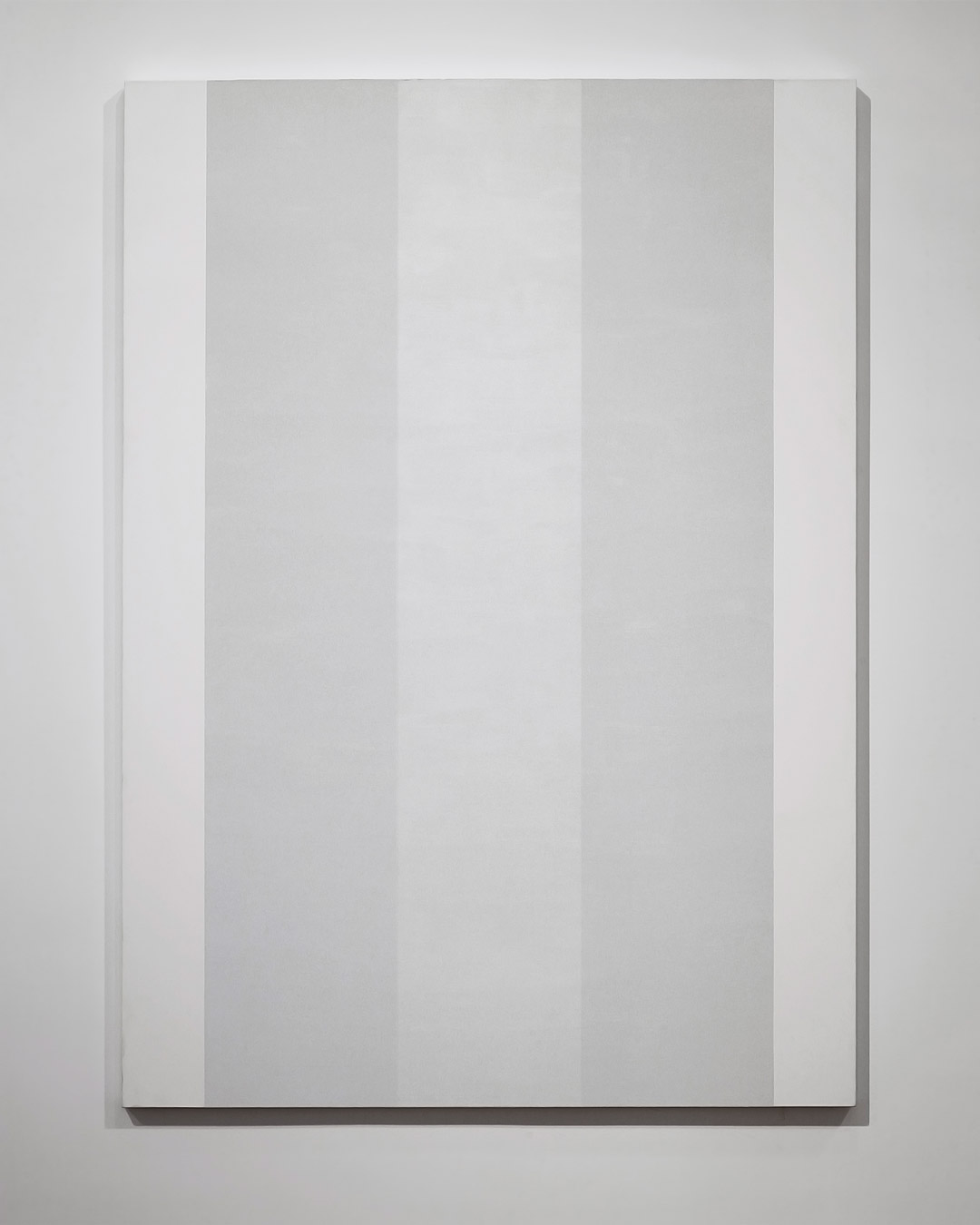Object of the Week: White Light Painting (Inner Band Series)
A photograph of Mary Corse’s White Light Painting (Inner Band Series) provides an idea at best of the composition of the painting—a large but shallow rectangular support, the canvas neatly stretched over the bars. Three vertical bands, varying slightly in tone with an almost silvery color seen in photographs, stretch from the top to the bottom of the canvas, framed by narrower matte white bands on the right and left margins. The delineations between the center three stripes in the image are blurry, but discernible.
White Light Painting (Inner Band Series) as it exists in a photograph is an entirely different painting from the actual painting in life. In the presence of the painting, its light, shadow, and color is elusive, and the thresholds of the three central bands—made of smooth layers of inherently colorless silica glass microspheres—recede and advance. As the viewer moves around the painting, the three central bands change value subtly in opposite directions. The outer bands of microbeads appear dimmer near the bottom of the painting and become more incandescent near the top, while the center band becomes more incandescent closer to the bottom of the painting, to a shimmering, undulating effect, up and down, as each band flashes in and out of visibility. The outermost stripes of matte acrylic white paint on the margins assume different hues according to the refraction of the light—briefly glowing pinkish green, then back to white, then nearly a dim gray in contrast to the flare emanating from the center as the silica glass microspheres bend light to create a prismatic field.
This is Corse’s goal: to instill dimension in her paintings not with illusion or figurative ground, but by using light as it comes into existence in the perception of the viewer, in real time, as the painting refracts it. It would be careless to assume that her paintings are simply about their shimmering finish.
Corse resists the easy association with California Light and Space artists. Though she lives in Topanga Canyon and shares some interests with those artists in her particular attention to light and space, the phenomenological experience of artworks and, perhaps distantly, her use of an industrial material for its surface qualities, Corse’s use of light is informed by its metaphysics, not by her particular locale.
It does happen that Corse began using silica glass microspheres in her paintings following an encounter with the material just outside Los Angeles. On a sunset drive in Malibu in 1968, she noticed the luminosity of the street signs and street markings. Corse had been searching for ways to incorporate light in her paintings, and turned to the microbeads, which are used in retroreflective paint for pavement marking. In her Inner Band series, the iridescent effect can be compared to the meticulous, seamless finishes of West Coast Minimalist paint applications, and yet it isn’t so mechanically applied that the surface appears manufactured.
Most notable to me are the ways this painting refers to and departs from the self-reflexive qualities of modern painting in the 1960s, in their attention to flatness and abstract use of form and color. The arrangement of the bands of microspheres in White Light Painting (Inner Band Series) at once describes and affirms the flatness of the surface in the evenness of the layers, and also breaks the plane apart into fugitive planes of light. Additionally, the contour of the bands, while elusive, are straight and rectangular, stretching vertically from the top to the bottom of the canvas. Even as the bands appear to flare and fade, they repeat the length and the form of the painting itself.
Corse’s color is not inherent to any pigment in the painting, but exists in flux in the eye of the viewer. Whereas other paintings use tints or shades for color, Corse’s microspheres use pure light, and the random, polychromatic color that comes from its refraction.
Experiencing White Light Painting (Inner Band Series) is deeper than the experience of looking or simply beholding it—you are apprehended by the painting as you spend time with it, paying attention to it and witnessing its permutations. It exists in glances of light, in full silvery columns, in the soft apparent glow at its margins, and the fluttery animation of its surface as you walk past. It is spectacular for its sparkle, but even more so for its ability to resist expectations of a definitive state of being.
– Hannah Hirano, SAM Coordinator for Museum Services and Conservation
References
Clark, Robin, ed. Phenomenal: California Light, Space, Surface. Berkeley, CA: University of California Press, The Museum of Contemporary Art San Diego, 2011.
Griffin, Jonathan. “’I paint for my sanity’ – an interview with Mary Corse.” Apollo International Art Magazine, August 4, 2018. https://www.apollo-magazine.com/i-paint-for-my-sanity-an-interview-with-mary-corse/
Miranda, Carolina A. “The ‘whoa’ moment and Mary Corse: The painter who toys with light is finally getting her due.” Los Angeles Times, November 2, 2017. https://www.latimes.com/entertainment/arts/miranda/la-et-cam-mary-corse-kayne-griffin-corcoran-20171102-story.html
Nichols, Matthew. “Mary Corse Is More Than a California Artist.” Art in America, February 8, 2012. https://www.artinamericamagazine.com/news-features/news/mary-corse-lehmann-maupin/
Image: White Light Painting (Inner Band Series), 1997, Mary Corse, acrylic, silica, glass microspheres, 60 × 84 in., Gift of the Virginia and Bagley Wright Collection, in honor of the 75th Anniversary of the Seattle Art Museum, 2014.25.12, © Artist or Artist’s Estate.
